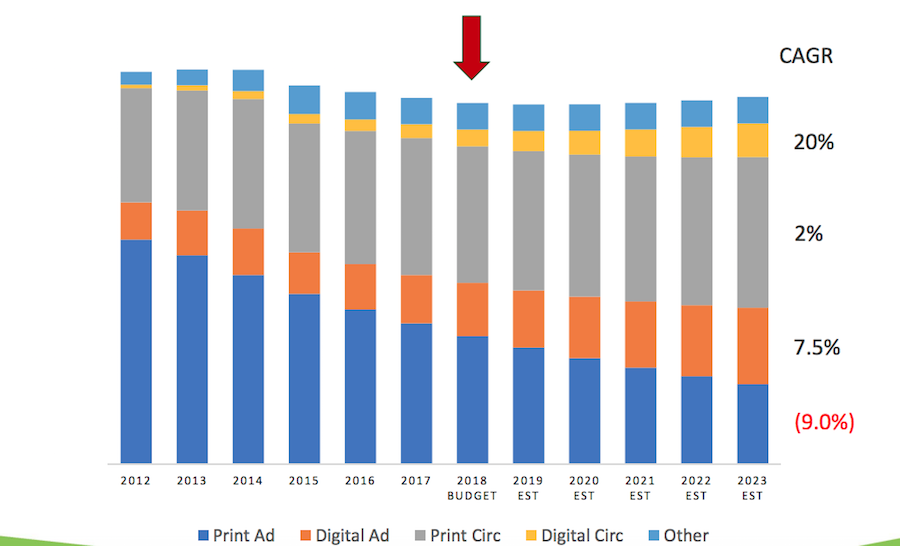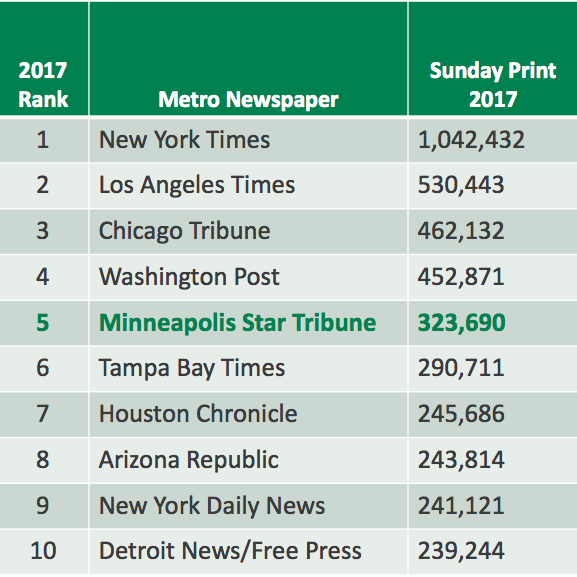Two years ago I chronicled how the Star Tribune of Minneapolis had become a widely celebrated fast horse in the slow field of metropolitan newspapers.
An enlightened billionaire owner, a talented publisher and a news-hungry civically attuned audience all have helped the Strib weather the continuing woes of sinking print advertising revenues and digital disruption. Even more important, a stream of innovative projects, well executed, have generated enough revenue to keep whole a well-staffed newsroom with 245 editors and reporters.
Now as the first financial results for 2018 begin to roll in, a second look seems in order. The organizers of the annual America East media conference also thought so when they invited publisher and CEO Mike Klingensmith to give the meeting's keynote in mid-March.
Two among Klingensmith's spartan collection of Power Point slides grabbed me.
The first is a chart showing revenues and projected revenues over a 12-year period. It doesn't look much like the downward ski slope you see in similar graphs for the industry as a whole.

Print advertising revenue is falling markedly at the Star Tribune as it is elsewhere. But the rate, Klingensmith told me in phone interview, has remained steady at about 9 percent. That's half the typical decline publicly traded chains have been reporting in recent quarters and reflects the Star Tribune's emphasis on keeping print strong.
The top band of the chart, while not expanding quickly, shows that "other" revenues like events, digital marketing services and printing contribute roughly 10 percent of the revenue total.
Like many peer companies, the Star Tribune is looking for the next phase of growth to come from paid digital subscriptions, with an expected revenue increase of 20 percent a year. But unlike many, the Star Tribune is not starting late from a tiny base. Its current digital-only total is roughly 50,000.
Digital subs at the Star Tribune fetch only half what print ones do, but the marginal cost of serving each added customer is near zero. Print circulation, by contrast is expensive to begin with given paper, production and circulation costs, and gets comparatively more so if routes thin out. "One of our biggest emerging issues is going to be delivery effectiveness," Klingensmith said.
The company expects digital advertising to keep growing 7.5 percent a year and print circulation revenues to show modest growth, too.
Add it all up, and the Star Tribune has shown total revenue growth in a few years like 2014 and small declines in the range of 1-2 percent for the rest. Last year, revenues were off 1.3 percent, Klingensmith said, and the current projection for 2018 is down 1.5 percent.
You can even see revenues trending up slightly for 2020 to 2023 in the chart. "The out years are not really a forecast," Klingensmith said, "more of a projection of what we hope to achieve."
A second noteworthy table shows where the Star Tribune stands among U.S. newspapers in Sunday print circulation — fifth after The New York Times, Los Angeles Times, Chicago Tribune and Washington Post.

The Twin Cities are not the nation's fifth biggest metro area — more like 16th. And while the Star Tribune has historically circulated throughout much of Minnesota, that more remote circulation accounts for only a little more than 10 percent of the total.
Given the continued reliance on print, I asked if the Star Tribune is being burned by the increased tariffs on Canadian newsprint, running as high as 30 percent. The paper has a different mix of suppliers than some feeling the brunt of the tariffs but has seen prices rise, too, Klingensmith said. So far, that is being handled by some reductions in the size of print papers and more sparing use of in-paper promos rather than by layoffs.
In a conversation last September, Klingensmith told me that the company starts budgeting by looking at the probable print advertising loss for the coming year and then figures how to make up as much of that revenue shortfall as possible,
Initiatives in 2017 included launch of a quarterly general interest magazine, sold on newsstands as well as inserted into the paper, and a big travel show. "There were already a lot of events here but we identified that as a hole in the market," Klingensmith said.
Plus the Star Tribune pulled out the stops for a series of 150th anniversary celebrations, a great revenue opportunity I have also seen done successfully at the Hearst Texas papers and the Post and Courier in Charleston.
Two years earlier, the Star Tribune acquired an alt weekly, City Pages, and began printing USA Today for its region. In 2016 it began an e-commerce initiative — that is, direct sales from its site.
This year it has introduced a foray into solutions journalism, a good-news Inspired section on Saturdays, with both a primary sponsor and other advertisers (not to be confused with religion coverage, which runs elsewhere). More innovation is on the way later in 2018.
Preparing a webinar recently, it hit me again that the replacement revenue problem for newspaper media companies is even harder than it looks at a glance. Each year with fresh print ad revenue losses looming, they need to hold the gains of the year before — retaining new digital subscribers, for instance, or doing a successful second edition of an event. And then they need to grow revenues from existing sources as well as adding new ones to the mix.
"That's pretty much the math of it," chief marketing officer Steve Yaeger agreed. "It is inescapable."
Continuity helps the Star Tribune keep pace. Klingensmith, who grew up in Minneapolis, returned as publisher in 2010 after a long career as a business side executive at Time Inc. His having a strong publishing background but without being tied to a newspaper mindset has helped.
Billionaire Glen Taylor, majority owner of the NBA Timberwolves, bought the Star Tribune for an estimated $100 million in 2014. It is not burdened by debt or big profit margin expectations. Taylor's daughter, Jean, is vice chair of the company, suggesting that family control could last well into the future.
I am not saying that the Star Tribune is bullet-proof — those optimistic out years might for an assortment of reasons not materialize. But at a time when there is ample cause for discouragement in the industry from extreme financial challenges, I would say the Star Tribune story is worth telling and retelling.







